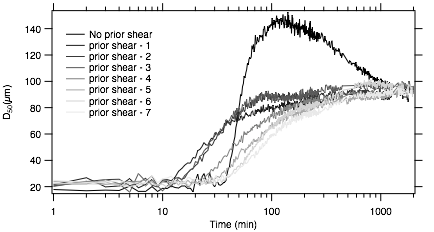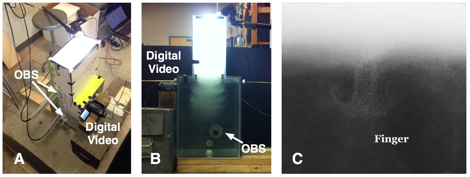58th Annual Report on Research 2013 Under Sponsorship of the ACS Petroleum Research Fund
Reports: ND851958-ND8: Scaling of Deposition Rates and Deposits from Buoyant River Plumes
Kyle Strom, PhD, University of Houston
Introduction
This work focuses on depositional processes in buoyant, mud-rich river plumes in deltaic settings. The speed at which sediment is removed from such plumes is thought to scale with the settling velocity of the individual or flocculated particles in the plume, i.e., with sediment size and excess density. However, some studies suggest that vertical flux may not be so simple. Various instabilities can result at the density interface that lead to more complicated depositional processes that may be a function of more than individual particle sediment size. This work compares the vertical transport rate of flocculated mud settling as individual particles to vertical transport rates in stationary and moving stratified layers.
The experimental work for the project is being carried out in three phases. Phase 1 focuses on the development of an experimental sediment mixture, characterization of the flocculation behavior of the sediment, and measurement of the settling velocity of individual flocculated sediment. Phase 2 measures the settling rate and behavior of flocculated buoyant freshwater suspensions overlying clear saltwater in a stagnant stratification chamber. Phase 3 will then measure the settling rate and behavior of flocculated buoyant freshwater suspensions flowing out over a stagnant body of saltwater.
Progress
Phase 1
Key items completed: (1) development of a clay mineral mixture with repeatable flocculation characteristics; and (2) quantification of floc size as a function of time under varying turbulent shear rate.
Methods: Flocculation test were run in a paddle-stirred mixing chamber using pure kaolinite, pure montmorillonite, and various combinations of the two. The goal was to produce a mixture with repeatable flocculation characteristics that had a cation exchange capacity similar to that of a sample from the subaqueous Brazos River delta near Freeport, TX. Once an appropriate mixture was found, the growth of flocs from unflocculated particles was measured under different turbulent shear rates and repeat cycles of floc growth and breakage. Experiments were also conducted to examine the change in floc size within a turbulent field that decays with time, similar to what might happen in a coastal river discharge. Measurements of floc size were all done without removal of the flocs from the mixing chamber using a camera system that images a 2 x 3 mm section of the suspension while it is being mixed.
Major findings to date: (1) An experimental sediment mixture of 80% kaolinite and 20% montmorillonite produced repeatable flocculation behavior with flocs ranging in size from 10 to 120 µm for turbulent shear conditions similar to what might be experienced in a decaying buoyant river mouth plume. (2) The number of formation and breakage cycles that a suspension of flocs goes through does not impact the equilibrium flocs size of our experimental mixture (Fig. 1). However, the number of growth and breakage cycles does slightly modify the time to equilibrium and the ultimate structure of flocs. (3) For the experimental sediment mixture, flocculation in a decaying turbulent field (similar to what occurs in buoyant river discharges) is significant enough to cause a 6 to 10 fold change in the settling velocity of individual flocs.
Figure 1. Floc growth from primary particles under steady turbulent shear for an increasing number of deflocculation and reflocculation cycles.
Items still in progress: (1) full quantification of the individual particle settling velocities. This is being done in tandem with the Phase 2 experiments to ensure that we are capturing the settling velocity of particles formed from the same suspension as those introduced to the stratification chamber.
Phase 2
Key items completed: (1) development and construction of the stratification chamber and integration of instruments; (2) experimental methods for the stratification chamber experiments; (3) a series of experiments to determine the impact of flocs formed with the sediment mixture on ADV acoustic backscatter and OBS readings; and (4) a portion of the stratification experiments (~ 4 experimental conditions)
Methods: For each experiment, a suspension of flocculated sediment is created using the mixing chamber and a known quantity of the clay mixture. The suspension first is subjected to sonification, flocculated under low turbulent shear, deflocculated with high turbulent shear, and then reflocculated under a constant shear similar to what might be experienced in a river mouth plume. Once an equilibrium floc size is reached, a sample of the suspension is placed in a settling column and the individual floc settling velocity is measured (Fig. 2). The remainder of the suspension is gently transferred to the upper section of the stratification tank (Fig. 3). Once the sediment laden freshwater has been introduced to the chamber, the horizontal gates are opened to allow upper and lower layers to meet. Suspended sediment concentration is measured just above the interface in the upper layer and near the boundary in the lower layer using calibrated OBS 3+ sensors (Fig. 3 & 4). Bulk settling rates from the stratification chamber are obtained with a 2-layer 1D sedimentation model based on conservation of sediment mass, and digital video is used to measure the velocity of the settling instabilities at the interface (Fig. 3).
Figure 2. floc settling chamber and imaging system with example images. Settling velocity is measured using the vertical distance traveled in successive images and the time between images.
Figure 3. (A) overhead image of the stratification chamber. (B) Front view of the tank with sediment settling out of the buoyant top layer, and (C) up-close image of an individual finger instability.
Figure 4. OBS output for the upper and bottom layers during a stratification experiment.
Major findings to date: (1) The acoustic Doppler velocimeter is sensitive to changes in floc sizes whereas the OBS is not; and (2) there is a broader range of instability morphologies than we originally thought. We are running a wide range of density differences between the upper and lower layers to better define the conditions for the various instabilities.
Items still in progress: (1) the remainder of the stratification experiments (~ 11 different conditions)
Copyright © 2014 American Chemical Society















